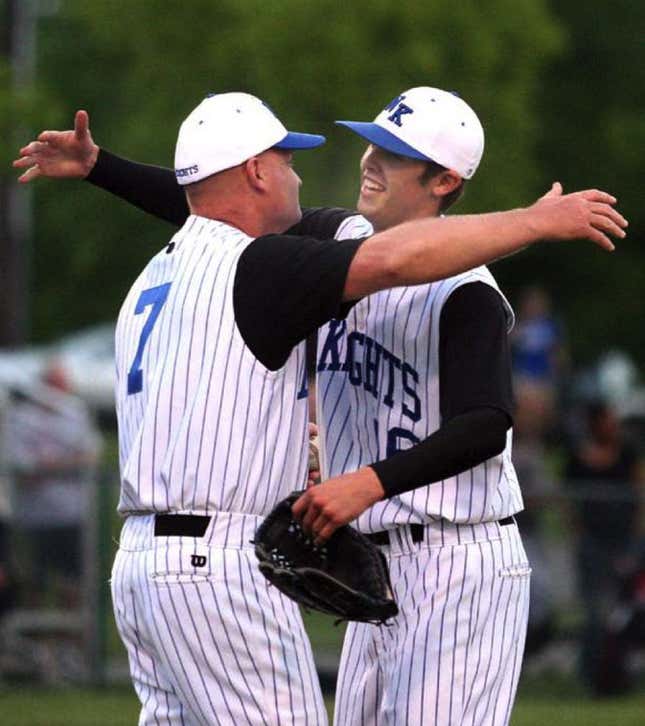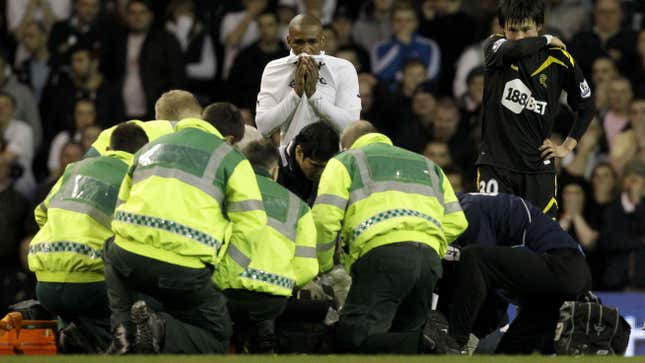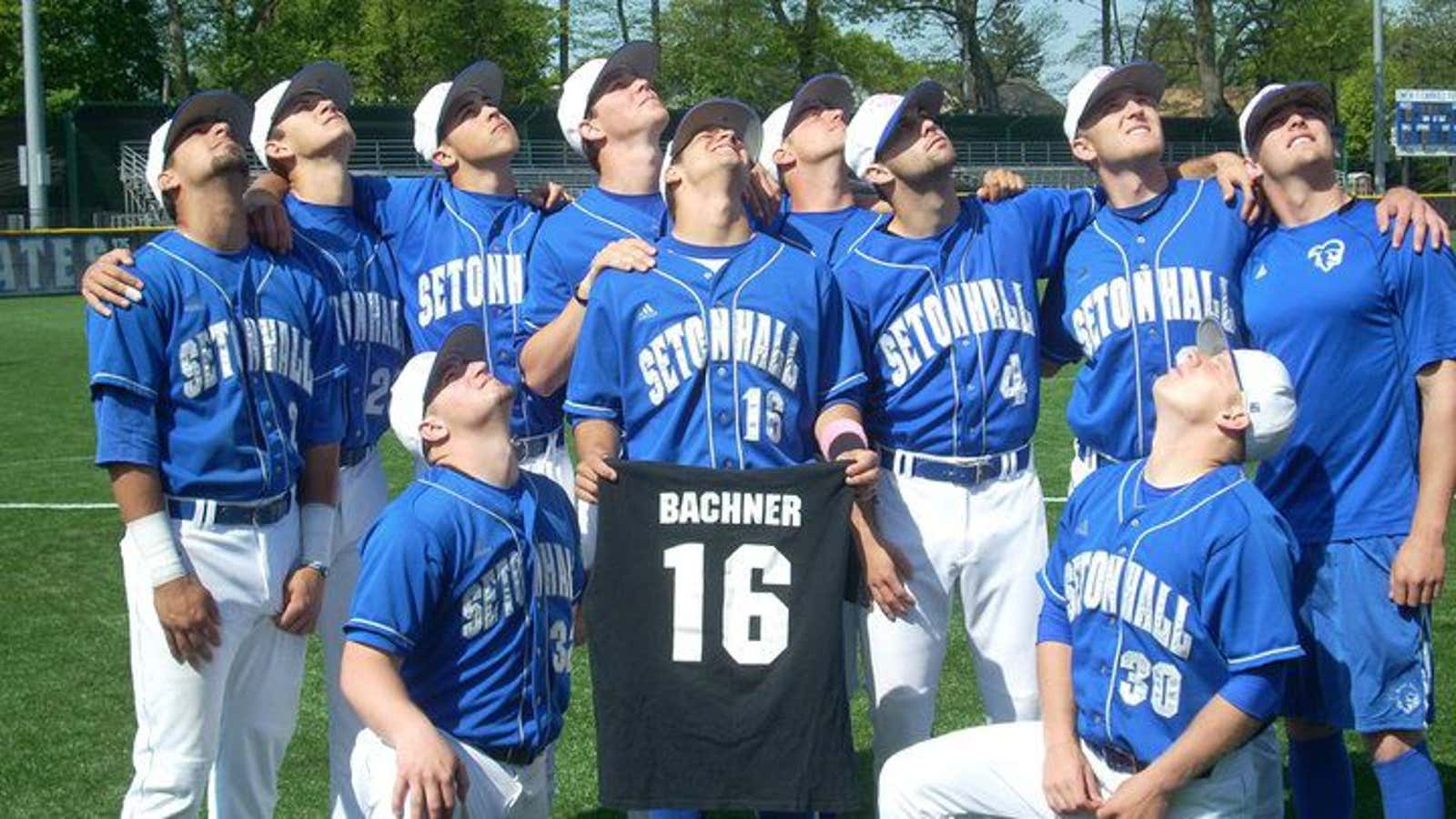Dr. Bennet Omalu, the renowned neuropathologist who demystified the degenerative brain disease chronic traumatic encephalopathy (CTE), wrote an op-ed in The New York Times on Dec. 7 urging parents not to let their kids play American football (paywall). “As we become more intellectually sophisticated and advanced, with greater and broader access to information and knowledge, we have given up old practices in the name of safety and progress,” he wrote. “That is, except when it comes to sports.”
He was, of course, referring to concussions. “Repetitive head trauma chokes the brain,” actor Will Smith—playing Omalu—says in the soon-to-be-released Hollywood blockbuster, Concussion. CTE, which can only be diagnosed posthumously, has been found in scores of former athletes, both young and old over the past 15 years. Among its symptoms are depression, anxiety, and memory loss. Concussion follows Omalu as he publishes his findings and takes on the incredibly powerful National Football League (NFL), which denied the epidemic for years and still seems to have little to no interest in talking about it.
The NFL might indeed be a league of denial, but others have accepted the concussion issue. New technology is working to thwart the prevalence of mild brain injuries. Improved safety protocols have standardized the methods of monitoring and treating concussions. I don’t know if kids should stop playing football or other high-contact sports, but the science is clear—it’s dangerous. On the other hand, so are a lot of things.
It’s good that attention is being brought to this issue. Measures are being taken to start mitigating some of the risk. But there is another, deadlier condition disproportionately affecting young athletes—and it hasn’t received nearly the same type of exposure as the concussion issue. Young men and women—many of whom are in otherwise immaculate physical shape—are dropping dead from undetected or unreported heart conditions.
A silent killer, an ineffective warning system
The US Centers for Disease Control (CDC) says that roughly 70 competitive athletes die from sudden cardiac arrest every year. One study puts that number even higher, at 110, or once every three days. The risk is three times greater in competitive athletes (paywall) under the age of 25 than in other young people.
“They call this the silent killer because we don’t know about it until it happens,” Rob Rehberg, a professor and athletic trainer at William Paterson University in New Jersey, tells Quartz. “The first sign or symptom they have is cardiac arrest.”
In the United States, a heart exam is not required for a child to play sports in school, at any level. All that is generally required is a routine physical from a doctor and a look at family history. But pediatricians fail to identify most heart disease and the combination of physical examination and basic medical history are ineffective at detecting some heart problems.
“In some states, you don’t even need a physical,” Rehberg notes.
The American Heart Association currently does not endorse widespread heart screening in athletes because it is not cost-effective and leads to too many false-positives, forcing athletes who are actually healthy to quit the sports they love. Instead it recommends a 14-point guideline system that relies heavily on family history.
That system, though, doesn’t seem to be enough.
“What we do now is neither effective nor cost-effective,” says Dr. Jonathan Drezner, a team physician for the NFL’s Seattle Seahawks and a former president of the American Medical Society for Sports Medicine. “We’ve tried their system for a couple of decades. It has a very low ability to identify disease.”
One disease it often fails to identify is hypertrophic cardiomyopathy (HCM)—a condition where the heart muscle grows too large and obstructs blood flow out of the organ. It regularly goes undetected during routine stethoscope exams. HCM killed Loyola Marymount basketball star Hank Geathers in 1990. It killed Louisiana State University baseball player Wally Pontiff Jr in 2002. It has killed NBA, NHL, and FIFA stars, as well as countless others whose names were not as famous.
Researchers at the Minneapolis Heart Institute Foundation estimate that one in every 500 people has HCM. Still, the US and the vast majority of other countries has no system in place to detect this disease—or any other heart disease—in athletes who are at high risk of dying because of them.
More troubling, sometimes diagnoses don’t help either.
When diagnoses aren’t enough
My longtime friend, David Bachner, was diagnosed with what was believed to be a minor case of mitral valve prolapse (MVP) in 2007, when he was 16. In severe cases, MVP can force blood to leak back into the left atrium, which can cause cardiac arrest. David, a baseball star at our high school, was told by his doctors that it wasn’t a big deal, and that he could resume playing.
“She told us it was a very common medical problem,” David’s mother, Rhonda Bachner, tells Quartz. “People live forever with it.”
So David kept playing. His lean, 6’3’’ frame towered over most hitters; with his head tilted down, brim fixed low on his eyes, he resembled former New York Yankees southpaw Andy Pettite. David was a sentry keeping watch over his field—immovable, unshakeable. Atop the pitcher’s mound he mesmerized and hypnotized hitters. Like so many young stars, he seemed immortal.
In 2009, his senior season at West-Windsor Plainsboro High School North in New Jersey, David coasted to a 9-2 record, tossing 125 strikeouts with an Earned Run Average (ERA) so low he was virtually unhittable. It was undoubtedly the best season in our school’s history and, according to Sports Illustrated, one of the best in the history of New Jersey. In the fall of that year David would head to Seton Hall University on an athletic scholarship, forgoing interest from several Major League Baseball teams because he wanted to experience college. Barring injury, he was on track to be drafted professionally anyway, his dream since childhood.
“He had a composure about him,” Seton Hall baseball coach Rob Sheppard tells Quartz. “He was always in control.”
But just weeks before he was to leave for school, David dropped dead in his bathroom. According to the coroner, he was dead before his body hit the floor.

Better screening protocols would not have saved him. And he died at rest, not during strenuous physical activity. (Rhonda Bachner said that the comedown from physical activity is what threw off the electrical wiring in David’s heart.)
David’s parents assert there was bias in the way his condition was treated, because he was a stellar athlete.
“I think the cardiologist didn’t want to have to tell him that he wouldn’t be able to play ball, if it came down to that,” Bachner says. David’s pediatrician never suspected a thing, and it was only after the doctor reluctantly referred them to a cardiologist—at her request—was the problem even discovered in the first place. ”They saw a healthy 18-year-old with no symptoms and just figured they would wait for the next time, but there was no next time,” she says.
Better screenings, better systems
Seahawks physician Drezner does not necessarily support a nationwide, mandated screening program, particularly because there aren’t enough physicians who can appropriately interpret an electrocardiogram (EKG)—the baseline diagnostic test for checking the electrical activity of the heart. Still, he sees flaws in the AHA’s current position.
“What I don’t understand is their continual promotion of a plan that doesn’t work,” he says. “They’re saying we can’t do EKGs because the false negative rate is too high, but we should do just a history and physical where the rate is more than twice as much. The argument makes no sense.”
Echocardiograms, an ultrasound of the heart that can detect almost all heart problems, typically cost hundreds of dollars per test. “It’s the gold standard, really,” William Paterson professor Rehberg explains. “There are some people in the medical profession that argue that the cost-benefit ratio is not high enough to support it. But try telling that to somebody who’s lost a child who might have been saved with an echocardiogram.”
There is precedent, in other countries, for an elevated state of caution. In Italy, all athletes between the ages of 12 and 35 are required to have an electrocardiogram before they are cleared to play sports. EKGs are less extensive than echocardiograms, but are still effective at catching HCM and other diseases. Research conducted after the Italian protocol was implemented showed that the incidence of sudden cardiovascular death in young Italian athletes declined significantly once mandated screenings were introduced, possibly as much as 90 percent.
Israel and Japan have similar systems. The AHA argues that the US population is too large and its healthcare system too overburdened for the same system to work effectively here.
That explanation isn’t enough for Drezner. “No matter how you look at the studies, they all have the same conclusion,” he says. “History and physical alone is the least cost-effective protocol we could employ and it’s the one that is currently the standard.”
Drezner believes the sheer divisiveness of the issue has, unfortunately, created a stalemate where the status quo remains and the problem persists. Change, without the support of the organization devoted solely to raising awareness for heart disease, will be hard to come by. “It has become a very polarized discussion within the medical community,” he said. “There’s a lot of bias that is presented in that discussion.”
Despite current protocol, some schools and organizations have put their own systems in place. Ninety percent of professional athletes today are tested for heart disease regularly. The NBA mandates that all players and potential players (college athletes who enter the NBA draft) receive an extensive electrocardiogram (the NCAA, however, has no such requirement). Many college athletic programs have also instituted similar systems of their own, and some private high schools have done the same. Indiana University, for instance, contracts with local cardiologists to offer echocardiograms to athletes for free.

But better screening processes are only part of the solution. Schools must also become better at reacting to a student who has gone into cardiac arrest. Rehberg believes American high schools and colleges need to hire more athletic trainers, install more defibrillators, and teach people how to properly use those defibrillators. Less than 3% of Americans have CPR training, and defibrillators are used in just 4% of cardiac arrests that occur outside of hospitals.
Some recent high-profile incidents involving professional athletes might help lead to improvements. In 2012, Fabrice Muamba, a 23-year-old soccer player in England’s Premier League, had a heart attack on the field during a match. Muamba was clinically dead for over an hour but miraculously survived after he was rushed to a hospital, where doctors were able to get his heart beating again. Muamba’s soccer career, however, was over.
In 2014, NHL player Rich Peverley of the Dallas Stars collapsed on the bench during a game. Seconds after he hit the ground, he was carried into the tunnel and resuscitated by Dallas medical personnel. A professional athlete, Peverley was immediately surrounded by trained doctors who knew how to revive him. Younger athletes are not afforded that luxury.
Simply put, until something changes in the way most of the world tests for heart problems, young athletes will continue to die. And many of those deaths will be preventable. High costs should not be an excuse for failing to implement better testing, especially in low-income communities where parents can’t pay for exams on their own.
“I know for a fact these screenings work,” Rhonda Bachner said. “If just a single child can be saved, wouldn’t it all be worth it?”
